Symi Travel Guide
Introduction
Symi Travel Guide – Symi, nestled in the Dodecanese archipelago, is renowned for its tranquility and unspoiled beauty. It is one of the smaller islands in the region, situated north of Rhodes and east of Tilos and Nisyros, with Kos to the south. Characterized by its mountainous and rocky terrain, Symi offers a unique landscape adorned with pine forests, particularly in the eastern part of the island. This secluded paradise appeals to those seeking peace and serenity.
Given its small size, Symi has only one bus serving the island. The limited road network makes renting a car unnecessary and impractical. Instead, visitors can explore the island’s attractions, including its pristine beaches, by boat. Numerous hiking trails also offer opportunities to venture into the island’s remarkable natural surroundings and discover hidden gems along the way. Whether by sea or land, Symi invites you to experience its intimate charm and revel in the tranquility it offers.
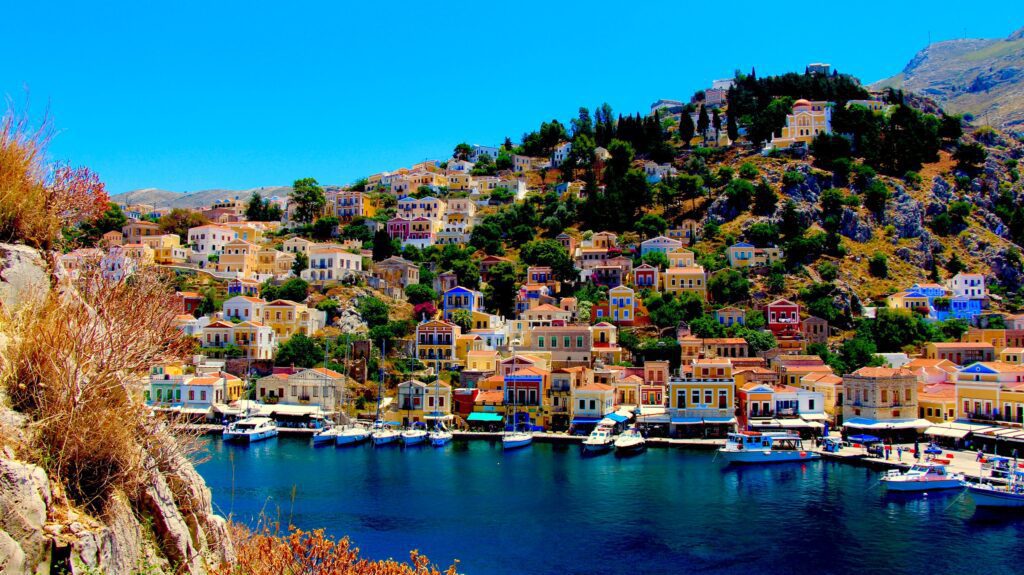
As you approach the harbor of Symi, a surge of emotions sweeps over you, for the sight that unfolds before your eyes is truly mesmerizing. The village’s quaint houses, adorned in a kaleidoscope of colors, cling to the mountainside, creating a scene straight out of a fairy tale. Symi is a place steeped in myth and legend, where its rich history intertwines with its very essence.
The beauty of Symi is simply breathtaking. Neoclassical mansions and weathered captain’s houses exude an air of elegance and dignity, while cobblestone courtyards and pebble mosaics exude an old-world charm. The vibrant bougainvillea flowers that cascade down the walls add bursts of color, enhancing the island’s romantic ambiance.
Immerse yourself in the enchanting atmosphere of Symi as you ascend the 500 stone steps, once bustling with activity and now serving as a testament to the island’s past. Take a leisurely stroll across the Cardelimi, a stone bridge known as the “Bridge of Love,” which connects the two sides of the village. Allow yourself to be transported back in time, envisioning the island’s proud shipbuilding heritage and the stories embedded within its walls.
Symi, like a living canvas, surpasses all expectations. Its regal presence, remote allure, rugged landscapes, and untamed beauty come together to create an unforgettable experience that embraces you with open arms. Get ready to be captivated by the sheer magnificence of this romantic island, where every moment is infused with the magic of Symi’s awe-inspiring surroundings.
History and Mythology of Symi
Myth and legend surround the ancient name of Symi. According to one tale, the island was known as Egli, named after the nymph who gave birth to the Three Graces. Another myth suggests that Symi was the name of a nymph who captured the heart of the sea god Poseidon, and they had a son named Chthonius, who became the island’s first king. Yet another story claims that Symi was named after the daughter of Ialysus and Dothida, who was abducted by Grafkos and taken to the island. Grafkos, a skilled fisherman and shipbuilder, became the first inhabitant of Symi, leaving a lasting legacy through his construction of renowned Argonautian ships. These myths add to the intriguing history and folklore surrounding the origins of Symi.
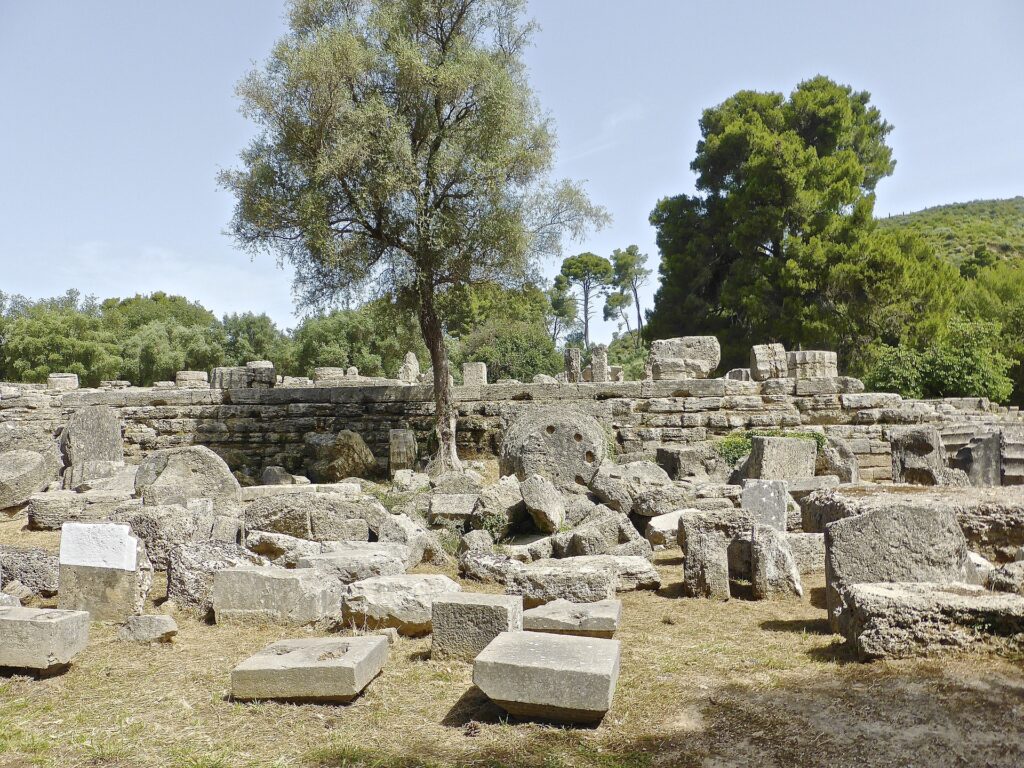
Symi has a rich history that dates back to prehistoric times, as evidenced by archaeological discoveries. Like the rest of the Dodecanese islands, Symi followed a historical trajectory that included various rulers. It came under the dominion of the Roman and Byzantine Empires, as well as the Knights of Rhodes, who played a significant role in the island’s development. The Knights supported the growth of shipbuilding, sponge fishing, and trade, contributing to Symi’s economic prosperity.
During the period of Ottoman rule, the people of Symi managed to secure important privileges from the Sultan, which further bolstered their status. At this time, Symi even served as the capital of the Dodecanese. The early 20th century was considered the golden age of Symi, characterized by economic success and cultural flourishing.
However, the island experienced a series of subsequent occupations. It was ruled by the Italians, followed by periods of British and German occupation. These occupations brought various challenges and changes to the island’s dynamics.
Finally, in March 1948, Symi was incorporated into Greece, becoming an integral part of the country. Today, the island’s rich history is evident in its architecture, traditions, and cultural heritage, inviting visitors to explore and appreciate its past while enjoying its natural beauty.
Beautiful Architecture
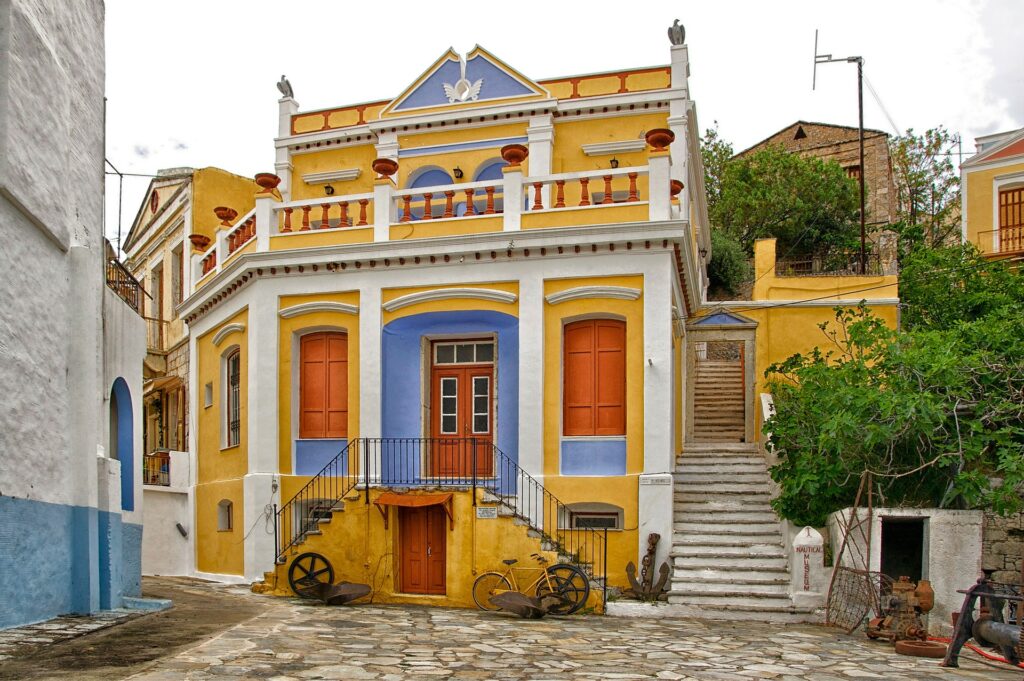
As you gaze upon the picturesque island of Symi, you can’t help but be enchanted by its neoclassical settlement. The charming village was strategically built at the foothills of the Vigla Mountains, providing security and protection against pirate invasions. This part of the village is known as Horio or Ano Symi. At the highest point of Horio, you’ll find the remnants of an ancient citadel and a knight’s castle, which add a touch of historical intrigue to the area.
From the castle, the settlement gradually expanded towards the shores of Symi, encompassing the neighborhoods of Gialos, Niborio, and Pedi. In 1971, the Greek Ministry of Culture declared the Symi settlement a protected area, recognizing its architectural and historical significance. The two- and three-story houses, characterized by cobbled courtyards, decorative motifs, gabled roofs, and iron balconies, contribute to the unique and noble character of Symi. The bold houses painted in pastel colors beautifully contrast with the island’s dramatic cliffs.
The harbor of Gialos, which began to take shape in the 15th century, features a dense layout with vaulted passages. Over time, it evolved into its present form during the early 20th century. The stunning houses in Gialos were crafted by skilled craftsmen from Carpathos. The upper part of Gialos stands out as an exceptional architectural example, showcasing an intriguing blend of Aegean architectural elements and Venetian fortification design.
It’s worth mentioning that the Symi residents were greatly influenced by European neoclassicism. They imported materials from various places, including Paros and Mount Pendeli for marble used in balconies and stairs, pumice from Santorini for masonry, plaster from Nisyros, wood for doors and windows from Trieste, and tiles from Marseille.
As you venture into Hora, you’ll discover one of the most beautiful areas called Kalodimou Street, also known as Kalistrata. The significant maritime activities and cultural connections between Egypt and Asia Minor played a role in shaping the neoclassical aesthetic of the city.
Symi’s architectural splendor, blending elements of history, culture, and international influences, creates an atmosphere of timeless beauty that will captivate any visitor.

As you explore further, you’ll have the opportunity to admire the grandeur of two- and three-story houses adorned with symmetrical doors and windows. These magnificent mansions belonged to affluent merchants and sea captains who brought with them artistic influences from the West through their extensive trading endeavors. These influences are evident in the vibrant colored stucco facades, gabled roofs, ornate cornice detailing on doors and windows, intricately carved wooden doors, and elaborate wrought-iron balconies.
In the district of Gialos, you’ll encounter buildings that showcase European neoclassical influences, exemplified by structures like the two-story Fotala House and the three-story Calafata House, which blend elements of Venetian and Neapolitan architectural styles. Other noteworthy landmarks in Gialos include the impressive bell tower built in 1881, a sculpture depicting a peace dove, and a statue of Michalakis created by Kostas Valsamis.
These architectural treasures in Symi’s Gialos district serve as a testament to the island’s rich history and the cultural exchange that occurred through trade and connections with Western influences. The harmonious fusion of local traditions and imported styles has created a truly unique and captivating architectural landscape that continues to charm visitors to this day.
Best Attractions of Symi
The Capital of Symi

Gialos Harbor, situated on the northern side of Symi, acts as the primary port for the island. This captivating village is renowned for its romantic atmosphere, characterized by neoclassical mansions and abandoned captain’s houses, cobblestone courtyards, and intricate pebble mosaics, all of which contribute to its aristocratic allure. The harbor is divided into two sides, connected by a stone bridge named Cardellimi, leading to the charming Kambos square.
To reach the capital of Symi, known as Horio, one must ascend the main staircase called the Kali Formation. This picturesque village showcases traditional elements such as an old manor house, a charming chapel, and a maze of winding cobbled streets that gracefully ascend the hillside. The Knight’s Castle, perched atop the settlement, overlooks the entire area and serves as a testament to its historical significance. Recognizing the architectural and cultural value of the village, the entire settlement has been designated as a protected monument since 1970.
Gialos Harbor and the surrounding village of Symi offer visitors a glimpse into the island’s rich history and architectural heritage. The combination of neoclassical elegance, traditional charm, and the commanding presence of the Knight’s Castle creates an enchanting atmosphere that transports visitors to a bygone era.
The Beach of Agios Georgios Disalonas
Agios Georgios Disaronas Beach stands as one of the Aegean Sea’s most remarkable coastal gems. Nestled on the eastern side of the island, this pebble beach boasts mesmerizing emerald waters. It is widely regarded as Symi’s most stunning beach, with its striking beauty set against a backdrop of a towering 300-meter cliff. To reach this exquisite destination, visitors can choose to embark on hiking trails originating from Pedi or opt for a scenic boat ride. Agios Georgios Disaronas Beach offers a tranquil haven where visitors can bask in the natural splendor of the Aegean coastline.

The Castle of the Knights
Located at the highest point of Ano Symi, the Castle of the Knights stands as a testament to the island’s rich history. Constructed by the Knights of St. John in 1407, this fortress was built on the ruins of the ancient Symi Acropolis to fortify the island’s defenses. Adorning the front gate of the castle is the coat of arms of the Knights Order, serving as a symbol of their presence and authority.
While the interior of the castle has undergone significant transformations over the centuries, the outer defensive walls remain, offering a glimpse into its former grandeur. Exploring the castle grounds provides visitors with breathtaking panoramic views of the surrounding area, allowing them to fully appreciate the strategic location chosen by the knights. The Castle of the Knights is not only a historical landmark but also a vantage point from which to admire the captivating beauty of Symi’s landscape.
The Monastery of Archangel Michael Panormitis
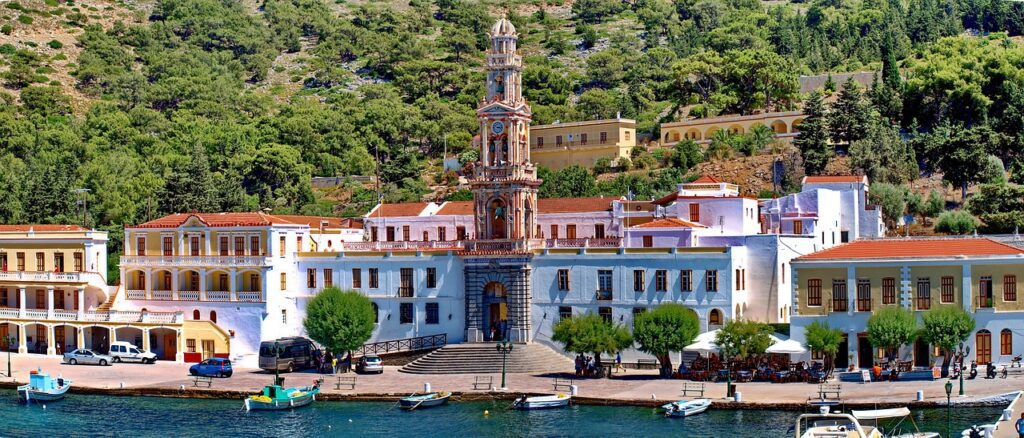
Located on the southwestern side of the island, the Archangel Michael Panormitis Monastery holds immense significance as one of the most revered pilgrimage sites in the Dodecanese. Constructed in 1783 by the architect Anastasis Karnavis, the monastery’s intricate decoration was carried out by local iconographers, the monks Neophytos and Kyriakos Karakostis. One of the monastery’s notable features is its imposing bell tower, which was added in the early 20th century and exhibits a Baroque style reminiscent of the bell tower of Zagorsk Monastery in Moscow.
Inside the monastery, visitors have the opportunity to explore captivating folklore and ecclesiastical collections, offering a glimpse into the cultural and religious heritage of the region. For those seeking a deeper connection to the spiritual ambiance, the monastery cell provides accommodations for up to 500 guests who wish to stay overnight and immerse themselves in the monastery’s serene atmosphere.
To access the monasteries, excursion boats depart from Gialos port, providing a convenient and scenic way to reach this important pilgrimage site. Embarking on this journey allows visitors to appreciate not only the architectural and artistic beauty of the Archangel Michael Panormitis Monastery but also the tranquil surroundings that make it a cherished place of devotion and spiritual reflection.
Pondikokastro
Located in the windmill area, Pondico Castro is believed to be one of the oldest monuments on the island of Symi. This peculiar round stone structure is known to locals as the Tomb of Nereus. Despite its historical significance, archaeologists have yet to determine the exact age of the monument. To reach the site, visitors must ascend the Kali tier by climbing 500 steps, eventually arriving at this intriguing ancient structure. The mystery and allure surrounding Pondico Castro make it a fascinating attraction for those interested in the island’s rich history and archaeological heritage.
Main Churches and Monasteries
- Agios Emilianos Chapel, located on the island of Agios Emilianos, is a charming chapel known for its idyllic setting to witness the awe-inspiring sunset. It is a popular spot for boat trips around the island, allowing visitors to appreciate its beauty.The Chapel of Our Lady of the Castle is a stunning chapel situated at the highest point of the castle. From here, visitors are treated to breathtaking panoramic views of the surrounding area, creating a truly memorable experience.The Cathedral of Timios Prodromos is a magnificent church located in the port of Gialos. It boasts a remarkable pebble courtyard and an impressive bell tower. This temple holds immense historical significance for the island, as it is intertwined with the island’s resistance against conquerors. During the Simi Festival, cultural events take place at the entrance of the courtyard, adding to the vibrant atmosphere.The Archangel Michael Panormitis Monastery is one of the most renowned pilgrimage sites in the Dodecanese, found on the southwest side of the island. Constructed in 1783 by architect Anastasis Karnavis, the monastery’s decoration was meticulously carried out by local iconographers, the monks Neophytos and Kyriakos Karakostis. The monastery is famed for its imposing bell tower, built in the early 20th century in Baroque style, reminiscent of the bell tower of Zagorsk Monastery in Moscow. Inside, visitors can explore intriguing folklore and ecclesiastical collections. Additionally, the monastery cell can accommodate up to 500 guests who wish to stay overnight. Excursion boats to the monasteries depart from Gialos port.
The Monastery of Archangel Michael Lukeniotis is a fortified monastery situated on the western side of the island. Dating back to the 15th century, it was built upon the remnants of an ancient temple once belonging to the Knights of St. John. The monastery holds immense historical value, and within its courtyard, shaded by a striking umbrella-shaped cypress tree, visitors can marvel at two remarkable temples adorned with important murals. The monastery celebrates on November 8th in honor of the patron saint of Symi, adding a special significance to the occasion.

Symi Travel Guide : Amphoras
Museums and Monuments
- The Archaeology and Folklore Museum of Symi is situated in the traditional residence of the Janeski family in Horio. It houses a diverse collection of archaeological artifacts, including classical, Hellenistic, and Roman inscriptions, pottery, textiles, and musical instruments. Visitors can explore the rich history of Symi through these exhibits.The Symi Church and Folk Museum is located within the Monastery of Archangel Michael Panormitis. This museum offers an intriguing collection of underwater antiquities, manuscripts, portable icons, and a display of sacred vessels. It provides insights into the religious and cultural heritage of the island.Housed in a beautiful neoclassical building in Cambos Square, the Symi Maritime Museum showcases relics of nautical equipment, such as old diving suits, maps, photographs, and ship models representing local vessels. Visitors can learn about the island’s strong maritime traditions and its close connection to the sea.The Aigli Reading Room, located in the Monastery of Archangel Michael Panormitis, is one of the oldest libraries in the Aegean Sea. It houses a collection of manuscripts focusing on ecclesiastical, historical, and philosophical topics. The reading room offers a glimpse into the intellectual pursuits and knowledge preservation of Symi throughout history.
At Halani Shipyard, visitors can witness the traditional craft of boat building using simple tools. As the last surviving shipyard on the island, Halani showcases the deep-rooted relationship between Symi and shipbuilding. During the Ottoman occupation, the people of Symi were granted the privilege of constructing the fastest ships by the Turks, highlighting their expertise and contribution to maritime activities.
These museums and sites in Symi provide unique insights into the island’s archaeology, folklore, maritime heritage, and intellectual pursuits, allowing visitors to delve deeper into the rich cultural tapestry of Symi.
Touring the Island
- Gialos, situated on the northern side of Symi, serves as the island’s main port and is known for its captivating charm. This picturesque village is often regarded as one of the most romantic in the Dodecanese. The presence of neoclassical mansions and abandoned captain’s houses, coupled with cobbled courtyards and pebble mosaics, creates an atmosphere of elegance and aristocracy. The village is divided by the scenic stone bridge named Cardellimi, which connects both sides of the harbor, leading to the delightful Kambos square. As you ascend the main staircase known as the Kali Formation, you’ll reach Horio, the capital of Symi. Horio is a visually captivating village characterized by traditional elements, including old mansions, charming chapels, and a network of meandering cobblestone streets that ascend the hillside. Standing majestically at the highest point is the Knight’s Castle, which encompasses the entire area. Recognizing its historical importance, the entire reservation has been designated as a protected building since 1970.Emboreios, also known as Niborio, is a coastal settlement nestled on the north side of Symi and renowned for its captivating appeal. It is hailed as one of the most charming fishing villages on the island, boasting stunning pebble beaches. Visitors are enchanted by the village’s quaint atmosphere, characterized by traditional houses adorned with red-tiled roofs. During the summer, taverns in the village offer delightful dining experiences, allowing visitors to savor the local flavors. Emboreios is an ideal destination for those seeking relaxation and tranquility, providing an escape from the bustling city life.Pedi, located on the northwest coast of the island, is a serene coastal settlement celebrated for its peaceful ambiance. Surrounded by breathtaking natural beauty, Pedi offers a tranquil haven for visitors. The village is particularly renowned for its delectable fish taverns, where guests can indulge in mouthwatering seafood dishes. Pedi is the perfect destination for those seeking respite from the hustle and bustle, offering a serene environment to unwind and immerse oneself in nature’s splendor.
Beaches of Symi
- Agios Emilianos, located on the western side of the island, boasts a picturesque pebble beach with crystal-clear waters that invite relaxation and tranquility. Adjacent to the beach is the charming Agios Emilianos chapel, creating a serene atmosphere for visitors to enjoy. This secluded beach can only be accessed by boat, ensuring a peaceful retreat away from the bustling crowds.On the eastern side of Symi, Agios Georgios Disaronas beach stands as a breathtaking gem. Adorned with emerald waters and surrounded by a majestic 300-meter cliff, it is considered the most stunning beach on the island. Whether reached by hiking trails from Pedi or by boat, Agios Georgios Disaronas promises a mesmerizing experience, allowing visitors to immerse themselves in the beauty of nature.Agios Vasilios, situated on the western side of the island, is a hidden gem known for its pristine pebble beach and crystal-clear waters. Secluded and serene, this beach offers an ideal setting for those seeking tranquility amidst the embrace of nature. With its magnificent cypress trees and picturesque surroundings, Agios Vasilios provides the perfect spot to witness captivating sunsets. Accessible primarily by boat, it guarantees a peaceful and unforgettable escape.For sandy beach enthusiasts, Agios Nicholas on the eastern side of Symi presents a delightful haven. Soft sands, azure waters, and towering pine trees create a postcard-perfect setting. Equipped with sunbeds, umbrellas, and taverns, Agios Nicholas ensures a comfortable and enjoyable beach experience. Whether reached by hiking trails from Pedi or by boat, visitors will be enchanted by the natural splendor and tranquility of this coastal retreat.
Mara Sounda, nestled on the southern side of the island, allures with its emerald waters and pebble shoreline. Tucked away in a serene corner, this secluded beach is perfect for those seeking peace and solitude. A charming restaurant on the beach offers a delightful dining experience, allowing visitors to savor the beauty of their surroundings while indulging in delicious cuisine.
Situated on the southeastern side of Symi, Nanou is celebrated as one of the island’s most enchanting beaches. With its pebble shore, azure waters, and graceful cypress trees, Nanou captivates visitors with its natural allure. The beach features a welcoming taverna, where guests can enjoy delicious meals amidst the stunning coastal landscape.
Nimborio, located on the northwest side of the island, is a picturesque pebble bay renowned for its emerald waters. Its close proximity to the city center makes it a popular choice among beachgoers. Nimborio offers a serene atmosphere where visitors can unwind and enjoy the pristine beauty of Symi’s coastal charm.
Practical Information About Symi
How to Get to to Symi?
Symi is primarily accessible by boat or ferry, adding to its charm as a secluded island getaway. There are ferry connections between Symi and Athens, with ferries departing from the port of Piraeus approximately three times a week. However, the journey by ferry from Athens to Symi can take around 20 hours, which may be a lengthy travel option.
For a more convenient and quicker way to reach Symi from Athens, it is recommended to take a short flight to Rhodes, which takes less than an hour. From Rhodes, there are ferry connections to Symi, making it an accessible option for travelers. If you are coming from Turkey, a suggested route is taking a ferry from Marmaris to Rhodes and then continuing the journey from Rhodes to Symi.
Symi can also be easily explored as a day trip from Rhodes Town. Rhodes has two ferry departure points. For high-speed catamarans, you can board the Dodecanese Pride and Dodecanese Express, which will take you to the Port of Colonna in Symi. If you prefer car transport ferries, the Panagia Schiadeni and Blue Star Diagoras Naxos ferries depart from Acandia Harbor in Rhodes.
It’s recommended to check the ferry schedules and availability in advance to plan your trip to Symi accordingly.
How to Get Around on Symi
If you decide to rent a car in Rhodes and embark on a day trip to Symi, it is advisable to leave your car behind in Rhodes. Exploring Symi on foot, using public buses, renting a scooter, or taking a taxi are more convenient options within the island.
Walking around Symi allows you to immerse yourself in its charming streets and take in the picturesque scenery at a leisurely pace. The island is relatively small, making it easily navigable on foot.
Public buses are available on Symi and can take you to destinations further away from the port, such as Panormitis. It is recommended to plan your schedule accordingly and check the bus timetables to ensure a smooth journey.
Renting a scooter provides a flexible and efficient way to explore Symi. It allows you to easily reach different parts of the island, including remote beaches and scenic viewpoints. However, please ensure you have the necessary license and experience to operate a scooter safely.
Alternatively, taxis are available on the island and can provide convenient transportation to various locations in Symi. Taxis can be found at designated taxi stands or can be arranged through your accommodation.
Consider your preferred mode of transportation based on your comfort, flexibility, and the locations you plan to visit during your day trip to Symi.
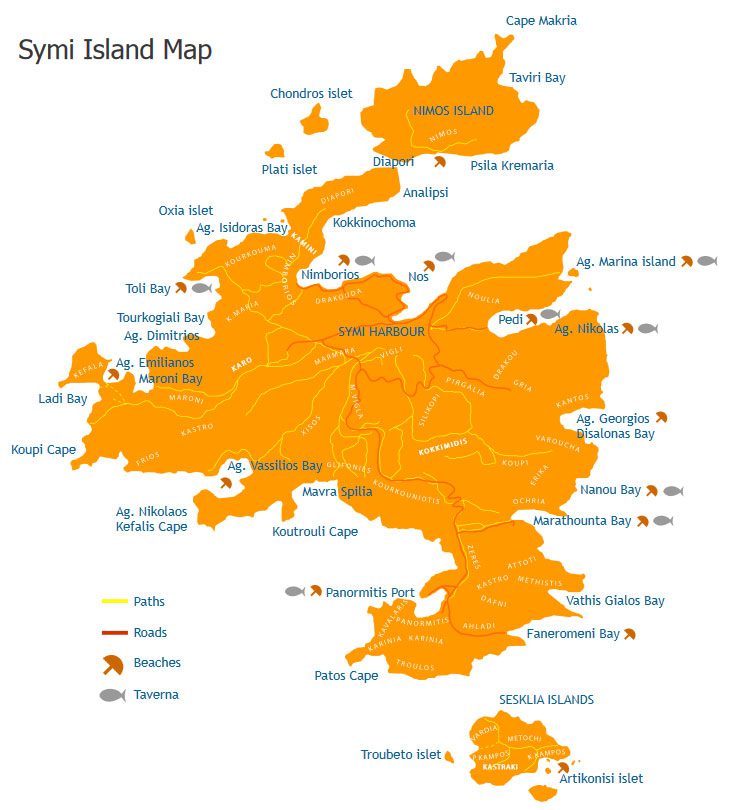
Weather in Symi
August is the hottest month of the year in Symi, offering warm temperatures for enjoying outdoor activities. June tends to be the wettest month, while January also sees some rainfall. Symi generally experiences pleasant weather throughout the year, with an average annual temperature of 22°C / 71°F. Snow is a rarity on the island, regardless of the month.
Symi is an excellent destination for sun-seekers, with August, July, September, June, and October being the sunniest months. However, there is a possibility of rain in July, August, and June. The months with the highest chance of rainfall in Symi are January (48%), February (34%), and December (34%).
If you’re visiting Symi in August, July, or September, be prepared for windier conditions, as these are the windiest months on the island. August, in particular, has an 11% chance of experiencing high winds.
Overall, Symi offers a pleasant climate throughout the year, allowing visitors to enjoy its sunny and warm weather for most of the year.











